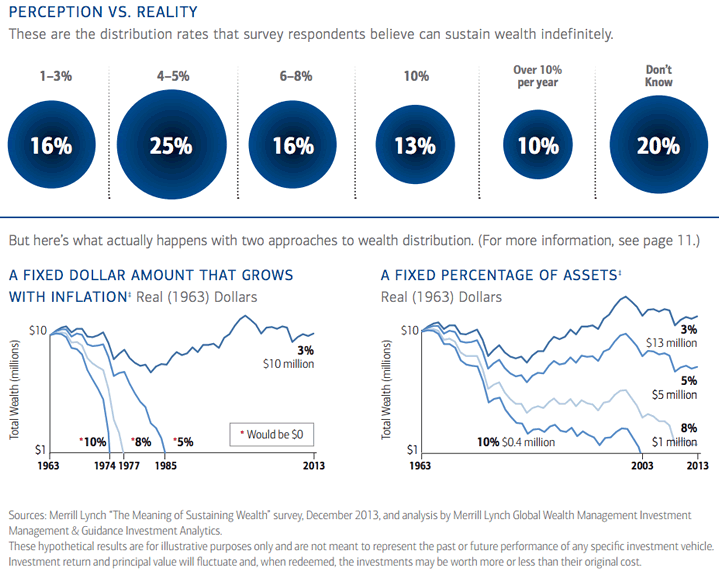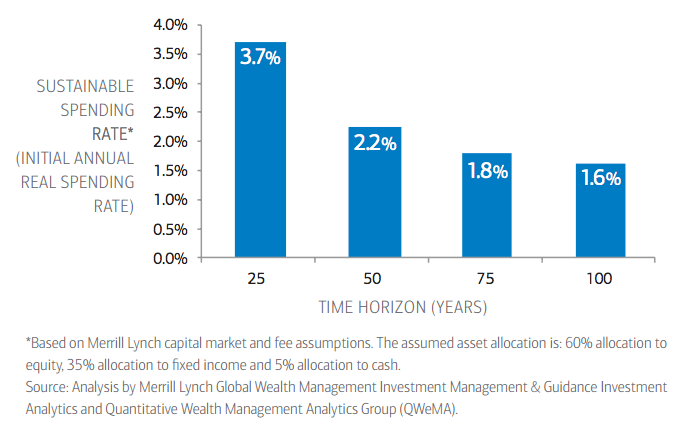Here’s another data point in the debate about safe withdrawal rates, or how much money you can safely withdraw from an investment portfolio each year without running out of money. Merrill Lynch Private Banking recently released a whitepaper on “sustainable wealth” aimed at high net worth individuals. Supposedly, in more than 67% of rich families, their wealth fails to outlive the generation following the one that created it, and 90% of the time, assets are exhausted before the end of the third generation.
Rich people problems? Sure, but one of the reasons for this high failure rate is that many people don’t have a reasonable idea of what makes a sustainable spending strategy. This applies to anyone who will eventually draw income from a portfolio for an extended period of time. Making a portfolio last generations is very similar to planning for early retirement. As we are talking about percentages, the numbers apply just as well to smaller portfolios.
Here are the results from a survey of wealthy families ($5M+):

Here are the safe withdrawal rates they calculated for a 60% stocks, 35% bonds, 5% cash portfolio based on “Merrill Lynch capital market and fee assumptions”.

I couldn’t find where they state what their confidence level is or what their “fee assumptions” are but I would assume they would at least be in the neighborhood of 1% annually. If you invest in low-cost index funds, that would theoretically mean you could increase the provided withdrawal rates by another 0.8% to 1%.
It looks like 3% is a good number if you want to be safe for 50 years, which is close to my investment horizon. Unfortunately, it is just a matter of luck whether you really need to take things that safely. From this other Merrill Lynch paper, starting with the same portfolio balance you could have taken out 5% a year (67% more income) starting in 1974 and your portfolio would have lasted just as long as if you withdrew only 3% starting in 1972. That is the potential effect of retiring just two years apart.
If I do use the 3% sustainable withdrawal rate, that works out to putting aside 33 times my annual expenses. To increase flexibility, I also like the idea of making the withdrawal rate somewhat dynamic (adjusts with investment returns) similar to how Vanguard Managed Payout Funds are structured.

 The Best Credit Card Bonus Offers – 2025
The Best Credit Card Bonus Offers – 2025 Big List of Free Stocks from Brokerage Apps
Big List of Free Stocks from Brokerage Apps Best Interest Rates on Cash - 2025
Best Interest Rates on Cash - 2025 Free Credit Scores x 3 + Free Credit Monitoring
Free Credit Scores x 3 + Free Credit Monitoring Best No Fee 0% APR Balance Transfer Offers
Best No Fee 0% APR Balance Transfer Offers Little-Known Cellular Data Plans That Can Save Big Money
Little-Known Cellular Data Plans That Can Save Big Money How To Haggle Your Cable or Direct TV Bill
How To Haggle Your Cable or Direct TV Bill Big List of Free Consumer Data Reports (Credit, Rent, Work)
Big List of Free Consumer Data Reports (Credit, Rent, Work)
It seems like this is a one-generation analysis. I bet that a lot of those second and third generation wealthy run out of money because their nest egg takes a pretty big hit as a result of the estate tax. Even if you spent an initial 3% per year and grew it by inflation you would probably run out of money in the third generation or earlier because 40% of the estate goes to estate taxes at each generational transfer. There is a $5 million exemption but the dollars in your charts are significantly above that, so a lot of that wealth will be taxable. So after accounting for the estate tax I would expect the sustainable payout rate to be even lower than 3% for second and third generations.
Maybe this is a stupid question, but why not open another brokerage account with my son (using his SSN), transfer all my investments into the new account, control the new account and teach my son the wisdom of intelligent investing I acquired over many decades. At the end, my son will simply continue taking care of the account the way I taught him. Will IRS demand taxes on the full value of the investments transferred from one account to another?
That’s a gift — there could be a gift tax on this, depending on the amount transferred and when the transfer occurs.
There is an annual gift tax exemption amount, which adjusts to the nearest $1,000 as indexed to inflation, but there’s also a lifetime amount, which mirrors the estate tax exemption. There are all sorts of ways to structure a hypothetical transfer to your son, which when multiplied by 10 or 100x of the money involved, which can shelter a variable portion of the transfer amount.
It seems as though the main reason that subsequent generations outspend the wealth is because the number of heirs most likely increases with each generation.
The 1972 vs. 1974 analysis is a bit simplistic – the person retiring in 1974 presumably had most of their nest-egg accumulated by 1972, and so lost nearly as much as a person retiring in 1972. As in the article, assume Bobbie had 250k in 1972 and retired – she is safe withdrawing 3% ($7500) that initial year and the same amount, adjusted for inflation, forever. Sure, if Billy retires in 1974, with 250k, he can withdraw 5% ($12500). But if Billy had 250k in 1972 (with 50/50 stock/bond split), and was saving, say, $4000/year, in 1974 his nest egg would be at about 200k, which is actually about $160k in 1972 dollars. Then if he retires in 1974, and could see into the future, that 5% safe withdrawal rate only gives him $8k/year (1972 dollars). In some ways Billy might be the unlucky one, as he doesn’t know that his 5% rate is safe, so he ends up working a few more years so he can live off a 3% withdrawal rate.
As an add-on:
My takeaway from this type of scenario is that we do have some insight into whether we are retiring in a “worst-case” year or not. If you trust that a worst-case safe withdrawal rate is 3%, and we’ve recently had a recession, you can map your savings back to just prior to that recession. In other words, you can say “my current nest egg is equivalent to what my nest egg would have been had I retired in [pre-recession year] with XX dollars and withdrawn 3%/year, so I could now retire on 3% of XX. So Billy could say “I have 200k now. If I would have retired in 1972 and withdrawn 3% per year, I would have needed $265k to be at $200k now. So I can safely withdraw 3% of $265k (~$8k).”
I dug into this a bit more, and on Reddit someone is claiming Merrill Lynch charges 2.7%/year for portfolios under 1mm. That is insane! Who in their right mind would pay that much?
At the bottom of the paper it still lists what is, to me, an insane amount – they use 1.3% in their fee calculations. So on a 10mm portfolio example, the wealthy individual would be paying out 130k/year to their advisor to run a simple 60/40 type allocation. That is ridiculous! Over 10 years that’s another 1.3 million+ they could have given to their kids. I hope no one gets suckered into these outrageous fees.
So to correct their paper, their estimated 1.6% 100+ year sustainable rate would actually be a ~2.8% 100+ year sustainable rate for anyone willing to just use Vanguard Funds instead of Merrill Lynch’s “services”. That’s the difference between living off $160,000/year and $280,000/year for a multi-generation sustainable portfolio.
…So using Merrill Lynch you are giving away almost half your investment returns!